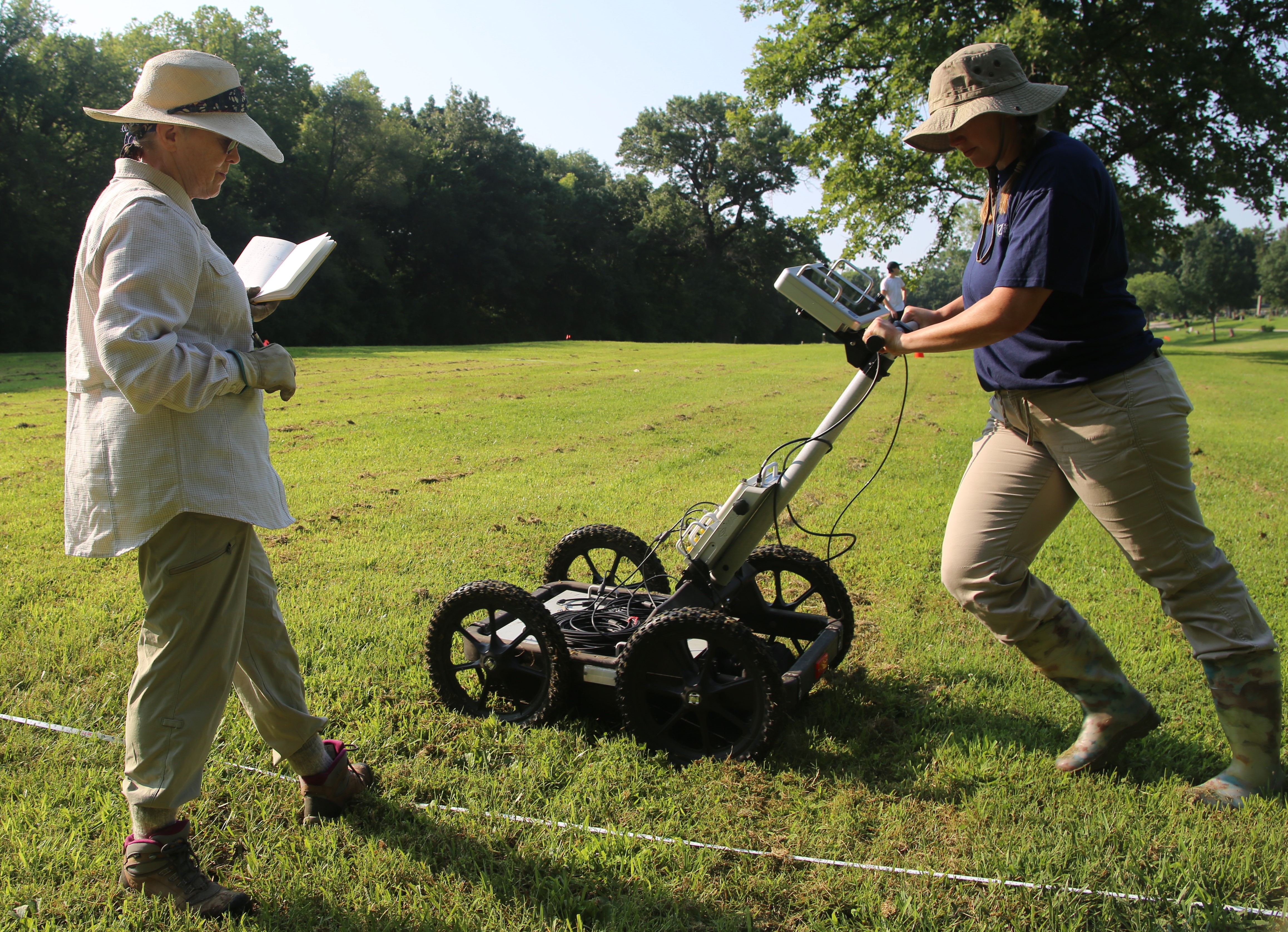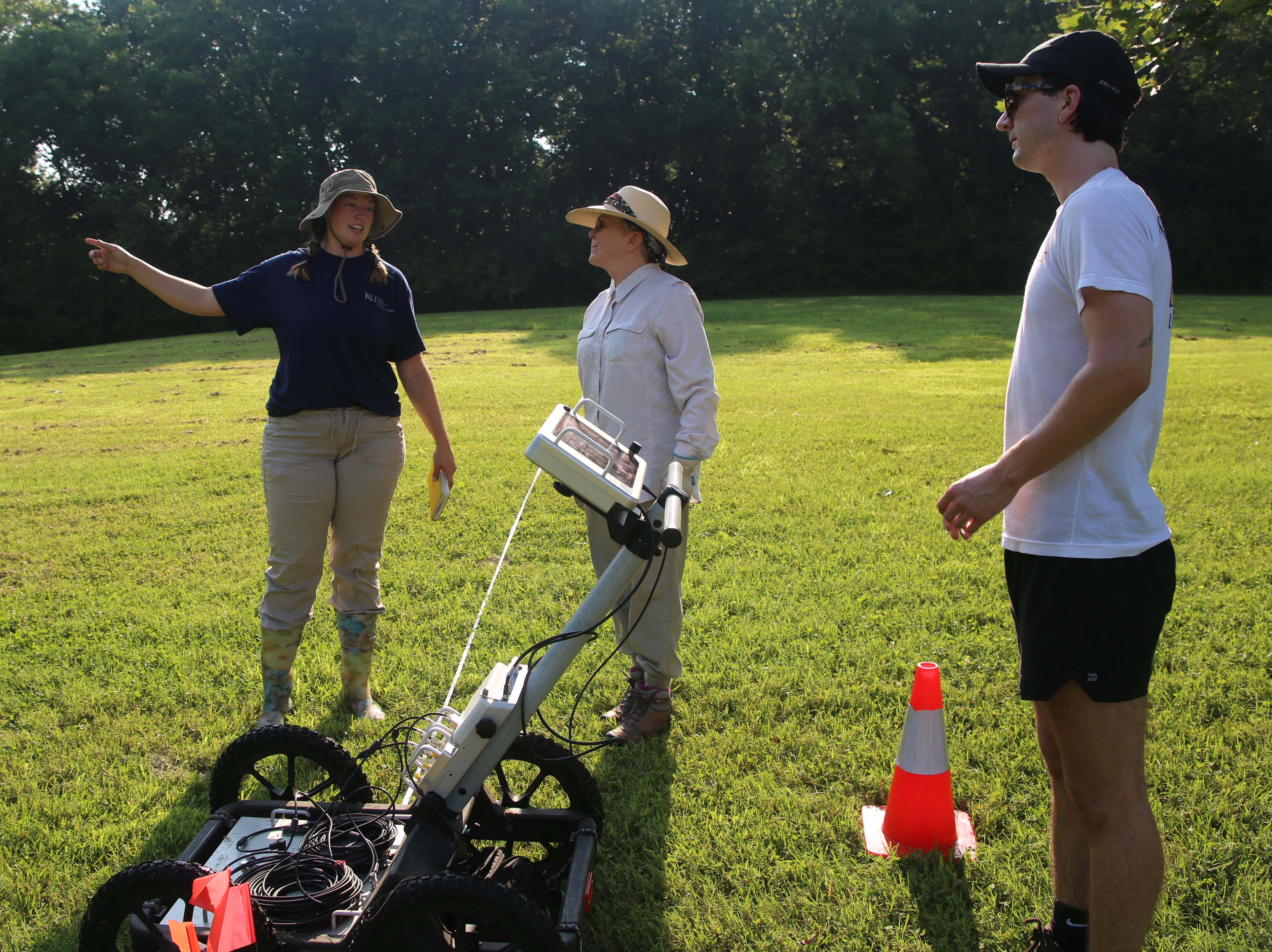#KUFieldWorks: Mapping unmarked graves in Oak Hill Cemetery

Editor’s note: Fieldwork provides invaluable insights about real-world environments and processes, expanding and reinforcing what researchers learn in classrooms, labs and collections. KU faculty, staff and students across a spectrum of disciplines are taking their inquiry directly to rivers, prairies, dig sites, glaciers, islands, burial grounds and more this summer. Through the #KUFieldWorks series, we'll join them on their adventures.
Q&A with Kansas Geological Survey associate researcher Blair Schneider
After local officials found evidence that three Black men who were lynched in Lawrence in 1882 are buried in Oak Hill Cemetery, Kansas Geological Survey associate researcher and science outreach manager Blair Schneider set out to locate their unmarked graves.
She and a team of volunteers are using ground-penetrating radar technology to map the area of the cemetery known as Potter’s Field — the edges on the northeast side of the cemetery where people who were unclaimed, unidentified or unable to afford headstones were buried.
The project aims to find the graves of Pete Vinegar, Isaac King and George Robertson and nearly 400 others buried there. The location of the three men’s graves wasn’t known until a Lawrence city clerk discovered a chart of cemetery plots while cleaning out a City Hall storage room, according to The Lawrence Times.
A local historian and chair of the History Committee of Lawrence’s NAACP chapter confirmed the newly discovered charts matched research the chapter started in 2019 for a project to commemorate the victims.
The chapter has since partnered with the Equal Justice Initiative on the Community Remembrance Project to document those killed in racial terror lynchings, including Vinegar, King and Robertson. A historical marker will detail the history of racially motivated killings in the United States, Kansas and Douglas County and tell of the stories of Vinegar, King and Robertson.
Schneider’s project aims not only to find the graves of the three men but also to adequately record Lawrence’s history for those who haven’t been represented in the past.
What methods are you using in your research?
We are using high-tech, ground-penetrating radar that uses electromagnetic waves. It’s like your radio or cell phone — it sends out a radio wave that records changes in the electrical properties of the ground. I can watch the reflections in real time as I'm moving the machine across the ground. We are also using electrical resistivity, which injects a current into the ground and measures how resistive the subsurface is. I’ll also use electrical conductivity, which is similar to the ground-penetrating radar. That instrument uses different frequencies to record changes in electrical conductivity within the ground. This technology allows us to see what’s beneath the surface. After analyzing the data, we’ll have a better understanding of what’s underneath.

Why does your study matter to society?
My degree is in geophysics, but I also have a minor in historical archaeology. Our history is incredibly important. I think there's a lot of our history that isn't adequately represented, and a lot of our history hasn't been preserved or recorded well. One of my research goals is to help us capture the history for those who haven't been represented in the past.
What are some memorable (funny, scary, surprising) moments from the field?
The connections! Someone who volunteered on this project used to work at the KGS, so I got to connect with her. Also, a couple of students who were in the anthropology club that we hoped to have help when we first started this project two years ago have been able to volunteer. I was really happy to still be able to make that connection with those students and that they could get this experience.

When is fieldwork frustrating, challenging or overwhelming?
All the time. Weather can be unpredictable and can make things difficult. Field safety isn’t frustrating, but it's always a concern. I get worried about anyone getting overheated or tripping in holes. I want to make sure everyone's safe while doing fieldwork.
What do you enjoy most about being in the field?
I love so many things about the field. I love being outdoors because I’m definitely a nature person. I even have a shirt that reads, "Wait, I see a rock.” I love that we have so many volunteers helping with this project. I love bringing people in and doing science with me. I feel like I've made eight new best friends already. For me, the best part about fieldwork is being outside, engaging with nature, and bringing people out here to have that experience with me as well.
Top photo: Vice President of Friends of Oak Hill Cemetery Denise Pettengill, left, and Kansas Geological Survey associate researcher and science outreach manager Blair Schneider push a ground-penetrating radar technology machine across the ground at Oak Hill Cemetery.
Second photo: Kansas Geological Survey associate researcher and science outreach manager Blair Schneider, left, and volunteers Denise Pettengill and Caleb Latas work to map the ground at Oak Hill Cemetery.
Third photo: Volunteers Denise Pettengill, left, and KU graduate Caleb Latas use a ground-penetrating radar machine to map the ground at Oak Hill Cemetery.